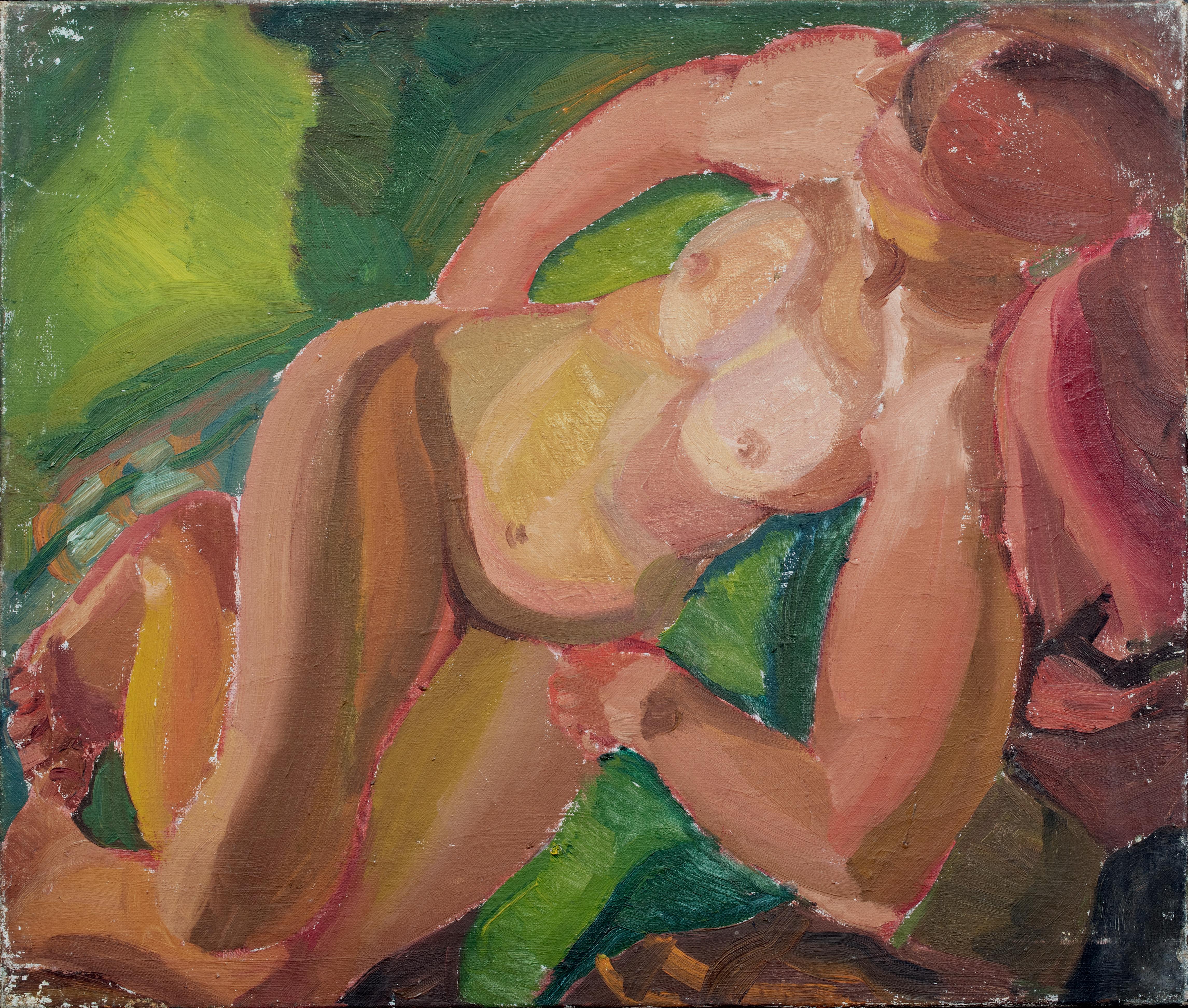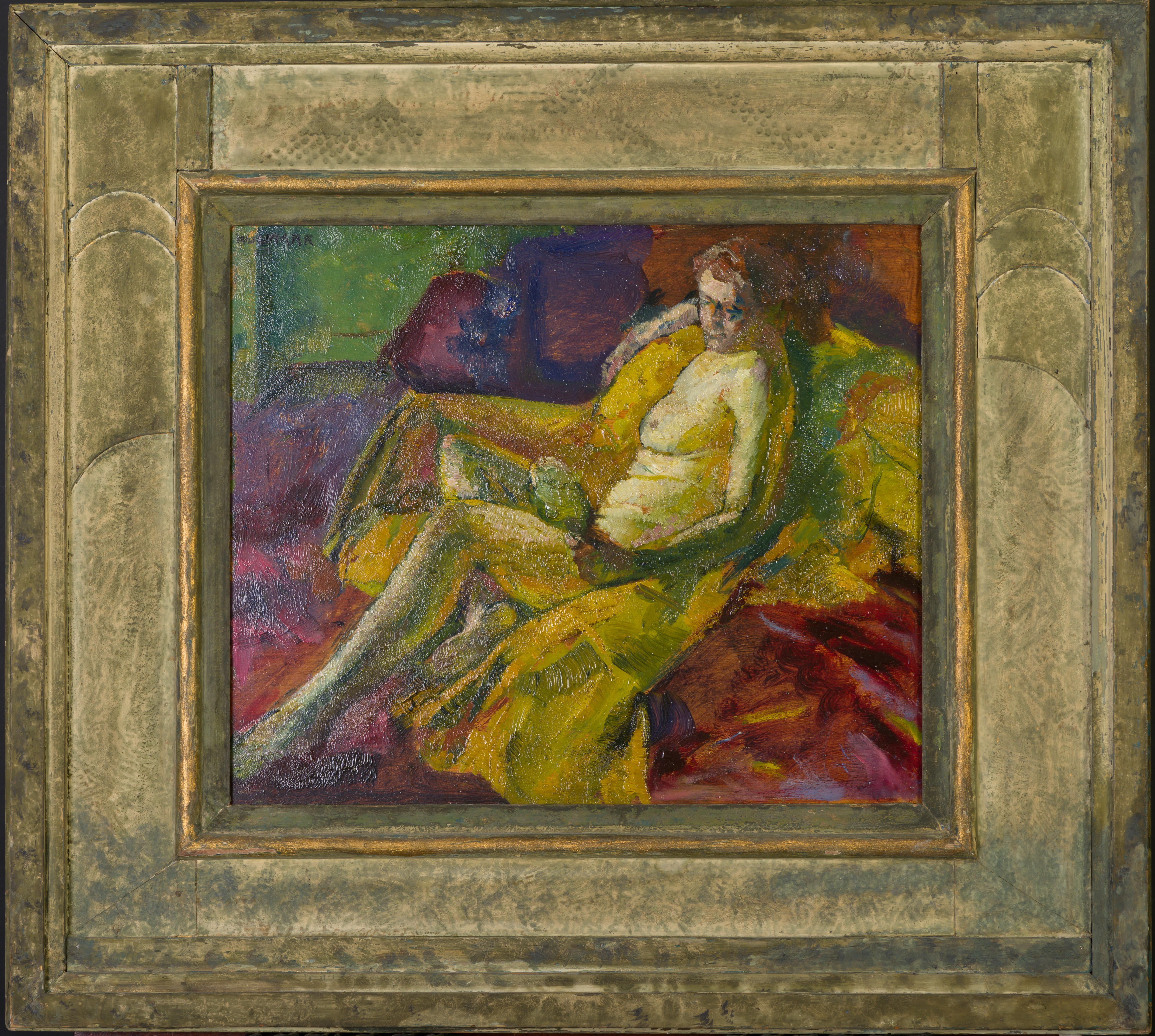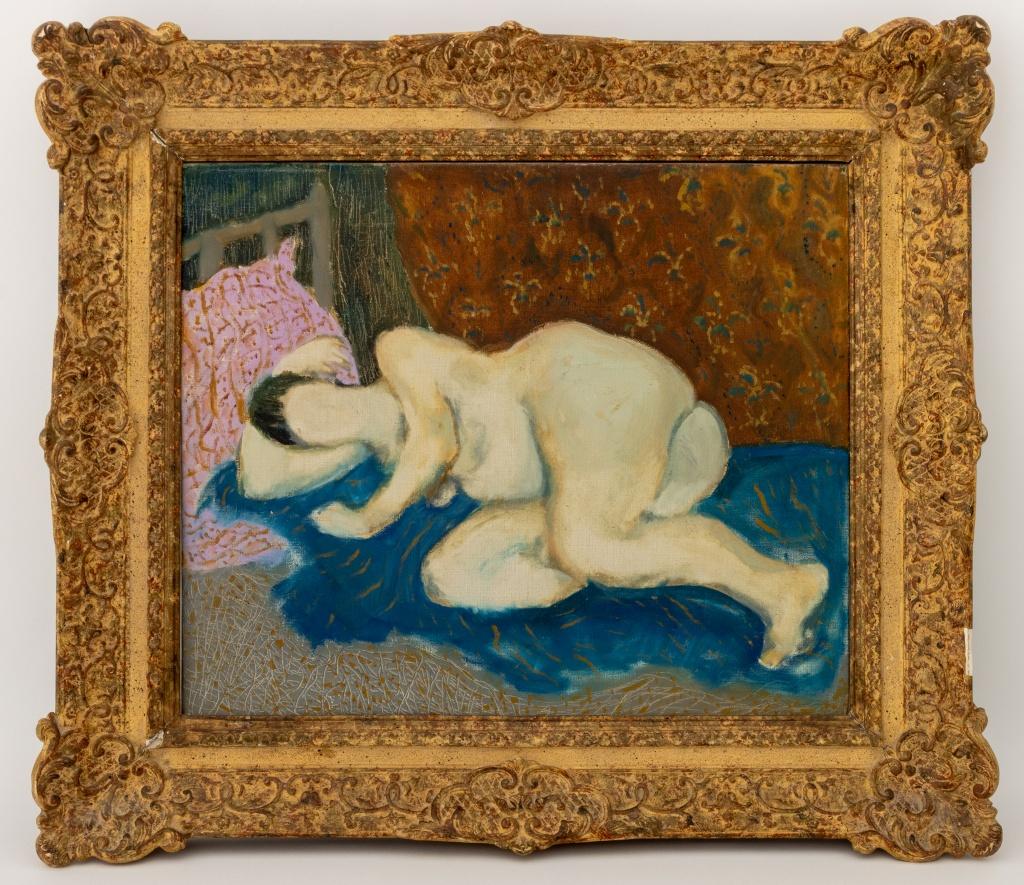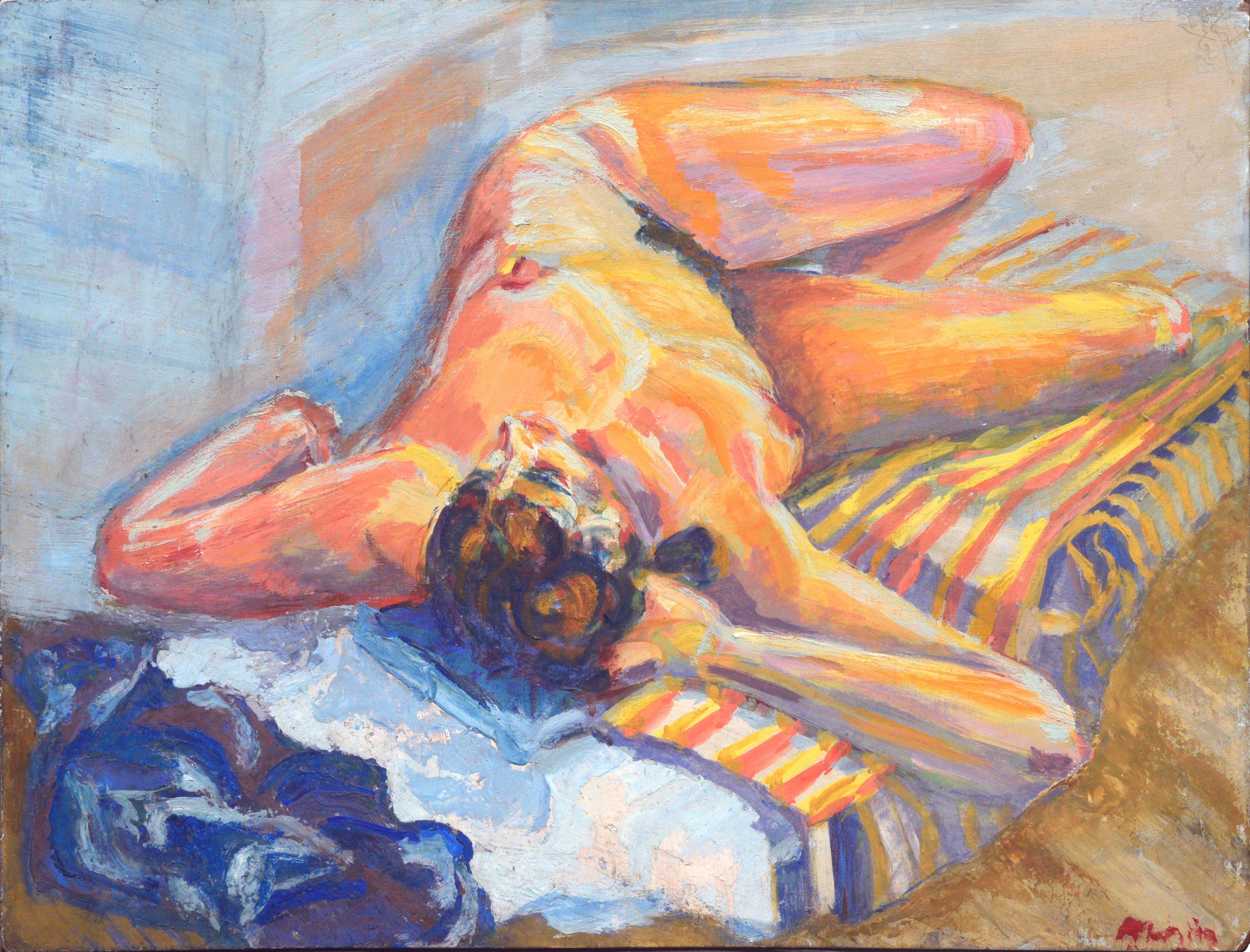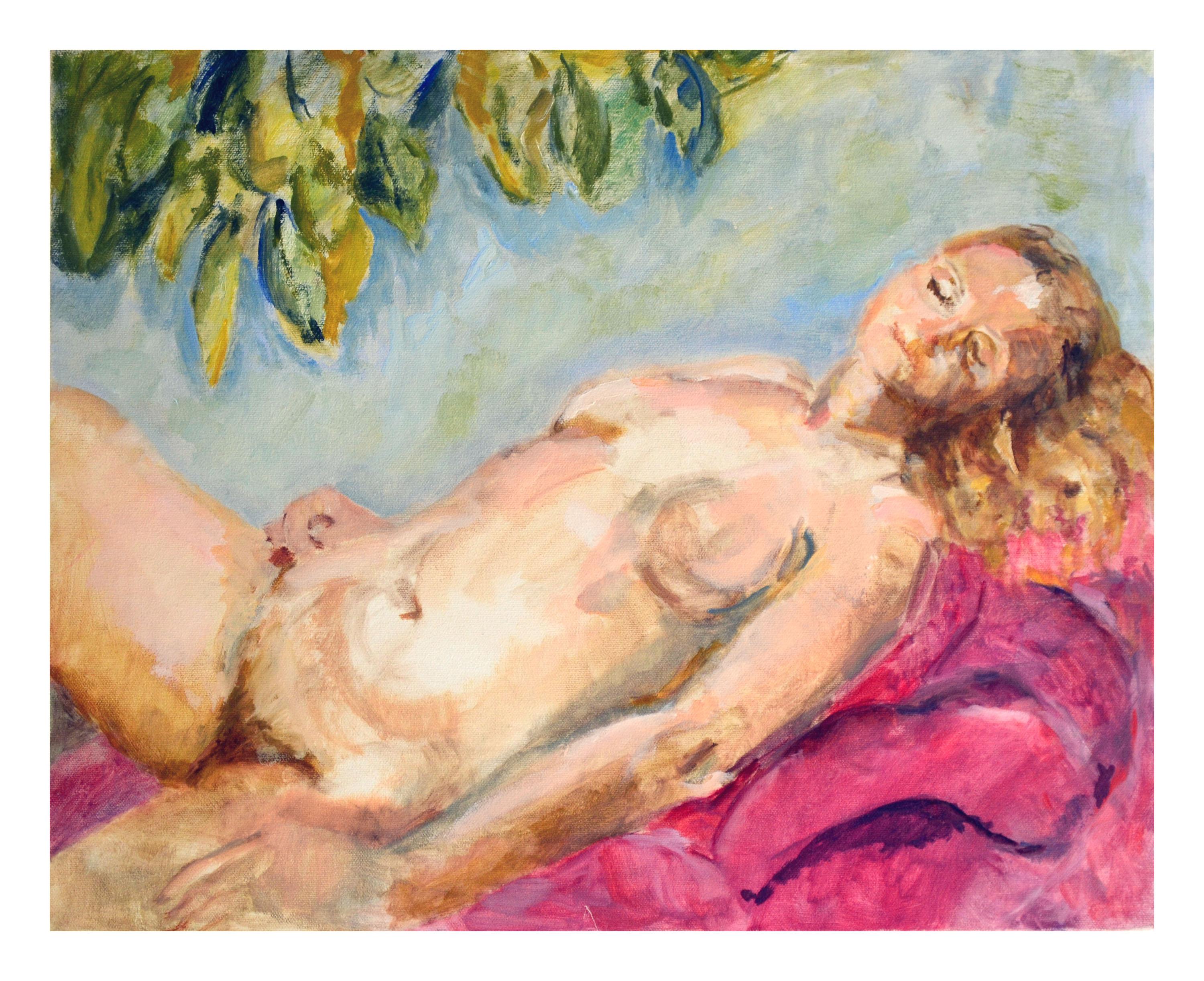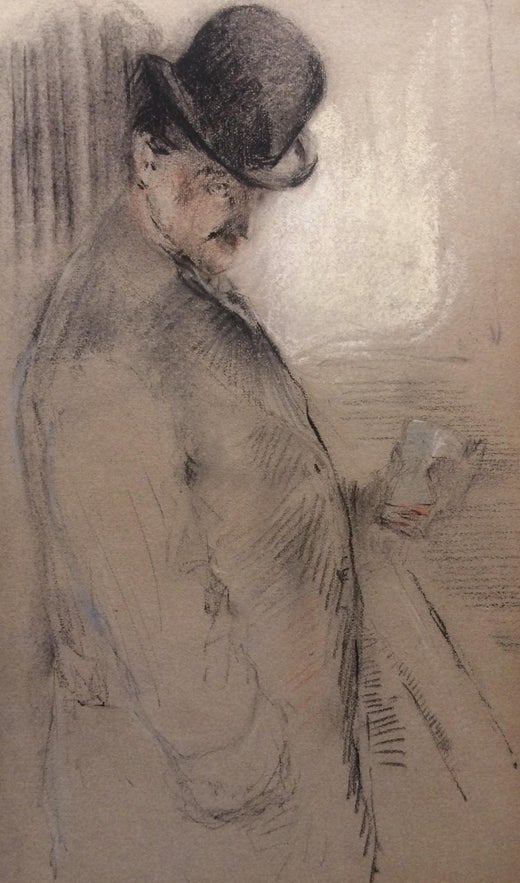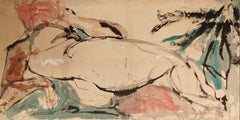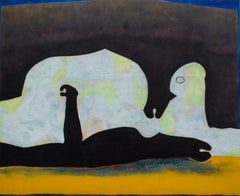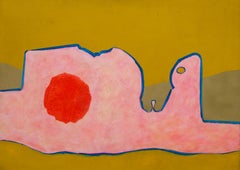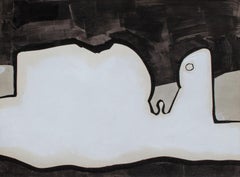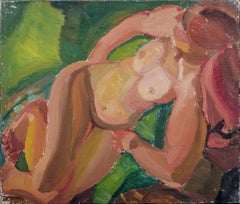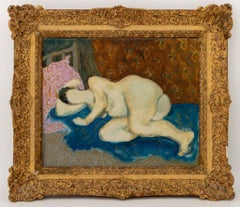Items Similar to "Reclining Nude" Arthur B. Carles, Abstracted Nude, Early American Modernism
Want more images or videos?
Request additional images or videos from the seller
1 of 8
Arthur Beecher Carles"Reclining Nude" Arthur B. Carles, Abstracted Nude, Early American Modernismcirca 1920
circa 1920
$70,000
£52,286.65
€60,618.03
CA$97,193.25
A$108,941.12
CHF 56,722.44
MX$1,330,217.70
NOK 720,168.96
SEK 682,655.40
DKK 452,276.16
Shipping
Retrieving quote...The 1stDibs Promise:
Authenticity Guarantee,
Money-Back Guarantee,
24-Hour Cancellation
About the Item
Arthur B. Carles
Reclining Nude, circa 1920
Inscribed "Mercedes Matter" on the overlap
Oil on canvas
32 x 51 inches
Provenance
The artist’s estate
Mercedes Matter, the artist’s daughter, by descent
Michael Altman Fine Art, New York
Exhibited
New York, TEFAF, May 4-8, 2018.
London, JC Gallery, Seven Americans: A contemporary exploration of American Modernism, January 22 - April 27, 2024, pp. 12-13, illustrated.
Known for his use of expressive and uninhibited color, Arthur B. Carles explored modernist principles without following a particular formula. At times, he arrived at artistic innovations in advance of other painters of his day. Considered a precursor of the Abstract Expressionists, he and his work were respected and admired by major critics and fellow artists including Hans Hofmann. He was recognized by ARTNews as one of the most important art teachers in America.
Born in Philadelphia on March 9, 1882, Arthur Beecher Carles, Jr., may have received his first artistic instruction from his father, who was a designer and amateur artist. As a young man, Carles studied at the Pennsylvania Academy of the Fine Arts between 1900 and 1907. His teachers—among them Thomas Anshutz, Hugh Breckenridge, Henry McCarter, Cecilia Beaux, and William Merritt Chase—were inspired by modern French painting and all stressed color and design to varying degrees. In 1903, Carles won the Henry P. Thouron Prize for best student composition and participated in the Philadelphia Watercolor Exhibition. Two years later, Carles was awarded the William Emlen Cresson Traveling Scholarship. Accompanied by artist friend George Oberteuffer, he visited London, Paris, and possibly Chase's class in Madrid.
In 1907, Carles embarked on another extended stay in France provided by the two-year Cresson scholarship. John Trask, director of the Academy, took a special interest in Carles and arranged for a commission from a Philadelphia church for a copy of Raphael's Transfiguration in the Vatican. Trask was later instrumental in placing the artist's work in the Panama-Pacific Exposition of 1915, where Carles won a silver medal for White Nude with Apple.
Carles stayed in Paris until 1910, immersing himself in the newest trends in art. He visited Leo and Gertrude Stein's salon and associated with other American artists such as John Marin and Edward Steichen. Carles was particularly attracted to the work of Paul Cezanne and Henri Matisse, and his canvases from this period reveal Matisse's influence. In March 1910, through Edward Steichen's intervention, Carles's work was included in the "Younger American Painters" show held at Alfred Stieglitz's New York gallery, 291. In its review of the show, the Philadelphia Inquirer remarked of Carles, "he represents more ably and fully than anyone else at present working in America the spirit of the new or modern movement in art in France today." Stieglitz gave Carles his first one-man show at 291 in January 1912. The following June, Carles returned to Voulangis, the village outside of Paris where the Steichens lived.
Carles returned from France in December 1912 with several landscapes, two of which he exhibited at the Armory Show of 1913. He painted still lifes with Breckenridge in which they used similar objects, and their compositions are almost indiscernible in style. By this time, Carles was a confirmed modernist and he became a fervent spokesman for modern art in Philadelphia. During this period, Carles also painted his only major allegorical piece, The Marseillaise (Philadelphia Museum of Art), inspired by his love of France. When exhibited at the Academy's annual exhibition of 1919, the painting took the Stotesbury Prize and the Fellowship Prize, and it was hung in the Place of Honor.
Carles was instrumental in organizing three exhibitions at the Pennsylvania Academy in Philadelphia with the help of Stieglitz and others and the encouragement of his friend Leopold Stokowski, the conductor of the Philadelphia Symphony Orchestra. His efforts took place in the context of the city's cultural renaissance of the teens and 1920s. The 1923 exhibition of European modernist paintings from the collection of Dr. Albert C. Barnes provoked particularly strong reactions. Carles also played an influential role as a teacher of younger artists. He taught the Saturday morning Sketch Class at the Academy from 1917 to 1925 and taught privately afterwards.
Carles lived in France for part of a year spanning 1921 and 1922, and for two years between 1929 and 1931. During this decade, he began experimenting with breaking up forms with cubist planes of color. After his return to the United States, he renewed his friendship with Hans Hofmann, whom he had met years before in Paris. He shared Hofmann's love for Fauvist color and interest in Cubist space. The two artists, accompanied by Carles's daughter Mercedes, who was Hofmann's pupil, lived together in Gloucester, Massachusetts during the summer of 1934.
In the last phase of his career, Carles painted a number of ambitious abstract compositions, despite repeated hospitalizations for alcoholism. His life as an artist drew to an abrupt close in December 1941 with a fall and stroke that left him an invalid until his death in 1952.
Carles is represented in major public collections, including the Metropolitan Museum of Art, the Whitney Museum of American Art, and the Museum of Modern Art, all in New York; the Newark Museum, New Jersey; the Baltimore Museum of Art; the Phillips Collection, the Hirshhorn Museum and Sculpture Garden, and the Corcoran Gallery of Art, all in Washington, D.C.; the Pennsylvania Academy of the Fine Arts and the Philadelphia Museum of Art in Philadelphia; and the Art Institute of Chicago.
- Creator:Arthur Beecher Carles (1882-1952, American)
- Creation Year:circa 1920
- Dimensions:Height: 35.5 in (90.17 cm)Width: 53 in (134.62 cm)
- More Editions & Sizes:Unique workPrice: $70,000
- Medium:
- Movement & Style:
- Period:
- Condition:
- Gallery Location:New York, NY
- Reference Number:1stDibs: LU1841216247212
Arthur Beecher Carles
Philadelphia Modernist Arthur Beecher Carles was born in Philadelphia and studied at the Pennsylvania Academy of the Fine Arts where he also taught and travelled to Paris on the prestigious Cresson Scholarship in 1907. Greatly influenced by French Fauvism and Post-Impressionism, Arthur B. Carles met and became friends with Matisse and others living in Paris. His work is in major museums including the Philadelphia Museum of Art, Pennsylvania Academy of the Fine Arts, Metropolitan Museum of Art and Whitney Museum of American Art. Carles' main subjects were nudes and still lifes. His nudes, painted between 1920-30, were heavily influenced by his trips to Paris; his model and muse in many of these paintings was Angele, a red-headed French girl who was persuaded by Carles' daughter, Mercedes to model for her father. Whether painting a still life or figure, Carles used the surface to apply abstract forms of color, defining his new "Modern" approach.
About the Seller
5.0
Platinum Seller
Premium sellers with a 4.7+ rating and 24-hour response times
Established in 2022
1stDibs seller since 2022
108 sales on 1stDibs
Typical response time: <1 hour
- ShippingRetrieving quote...Shipping from: New York, NY
- Return Policy
Authenticity Guarantee
In the unlikely event there’s an issue with an item’s authenticity, contact us within 1 year for a full refund. DetailsMoney-Back Guarantee
If your item is not as described, is damaged in transit, or does not arrive, contact us within 7 days for a full refund. Details24-Hour Cancellation
You have a 24-hour grace period in which to reconsider your purchase, with no questions asked.Vetted Professional Sellers
Our world-class sellers must adhere to strict standards for service and quality, maintaining the integrity of our listings.Price-Match Guarantee
If you find that a seller listed the same item for a lower price elsewhere, we’ll match it.Trusted Global Delivery
Our best-in-class carrier network provides specialized shipping options worldwide, including custom delivery.More From This Seller
View All"Untitled" Vivian Springford, 1960s Color Field Abstract Expressionist Forms
Located in New York, NY
Vivian Springford
Untitled (Rice Paper Mounting), 1963-65
Signed lower left
Ink, watercolor and acrylic on rice paper laid to canvas
27 1/4 x 53 3/8 inches
A contributor to Abstrac...
Category
1960s Color-Field Abstract Paintings
Materials
Canvas, Ink, Watercolor, Rice Paper
"Cronus Asleep in the Cave" David Hare, Large Abstract Surrealist Composition
By David Hare
Located in New York, NY
David Hare
Cronus Asleep in the Cave, 1971
Acrylic on linen
55 x 67 inches
“Freedom is what we want,” David Hare boldly stated in 1965, but then he added the caveat, “and what we are most afraid of.” No one could accuse David Hare of possessing such fear. Blithely unconcerned with the critics’ judgments, Hare flitted through most of the major art developments of the mid-twentieth century in the United States. He changed mediums several times; just when his fame as a sculptor had reached its apogee about 1960, he switched over to painting. Yet he remained attached to surrealism long after it had fallen out of official favor. “I can’t change what I do in order to fit what would make me popular,” he said. “Not because of moral reasons, but just because I can’t do it; I’m not interested in it.”
Hare was born in New York City in 1917; his family was both wealthy and familiar with the world of modern art. Meredith (1870-1932), his father, was a prominent corporate attorney. His mother, Elizabeth Sage Goodwin (1878-1948) was an art collector, a financial backer of the 1913 Armory Show, and a friend of artists such as Constantin Brancusi, Walt Kuhn, and Marcel Duchamp.
In the 1920s, the entire family moved to Santa Fe, New Mexico and later to Colorado Springs, in the hope that the change in altitude and climate would help to heal Meredith’s tuberculosis. In Colorado Springs, Elizabeth founded the Fountain Valley School where David attended high school after his father died in 1932. In the western United States, Hare developed a fascination for kachina dolls and other aspects of Native American culture that would become a recurring source of inspiration in his career.
After high school, Hare briefly attended Bard College (1936-37) in Annandale-on-Hudson. At a loss as to what to do next, he parlayed his mother’s contacts into opening a commercial photography studio and began dabbling in color photography, still a rarity at the time [Kodachrome was introduced in 1935]. At age 22, Hare had his first solo exhibition at Walker Gallery in New York City; his 30 color photographs included one of President Franklin Roosevelt.
As a photographer, Hare experimented with an automatist technique called “heatage” (or “melted negatives”) in which he heated the negative in order to distort the image. Hare described them as “antagonisms of matter.” The final products were usually abstractions tending towards surrealism and similar to processes used by Man Ray, Raoul Ubac, and Wolfgang Paalen.
In 1940, Hare moved to Roxbury, CT, where he fraternized with neighboring artists such as Alexander Calder and Arshile Gorky, as well as Yves Tanguy who was married to Hare’s cousin Kay Sage, and the art dealer Julian Levy. The same year, Hare received a commission from the American Museum of Natural History to document the Pueblo Indians. He traveled to Santa Fe and, for several months, he took portrait photographs of members of the Hopi, Navajo, and Zuni tribes that were published in book form in 1941.
World War II turned Hare’s life upside down. He became a conduit in the exchange of artistic and intellectual ideas between U.S. artists and the surrealist émigrés fleeing Europe. In 1942, Hare befriended Andre Breton, the principal theorist of surrealism. When Breton wanted to publish a magazine to promote the movement in the United States, he could not serve as an editor because he was a foreign national. Instead, Breton selected Hare to edit the journal, entitled VVV [shorth for “Victory, Victory, Victory”], which ran for four issues (the second and third issues were printed as a single volume) from June 1942 to February 1944. Each edition of VVV focused on “poetry, plastic arts, anthropology, sociology, (and) psychology,” and was extensively illustrated by surrealist artists including Giorgio de Chirico, Roberto Matta, and Yves Tanguy; Max Ernst and Marcel Duchamp served as editorial advisors.
At the suggestion of Jacqueline Lamba...
Category
1970s Abstract Paintings
Materials
Linen, Acrylic
"Cronus Asleep in the Cave" David Hare, Mythological Surrealist Composition
By David Hare
Located in New York, NY
David Hare
Cronus Asleep in the Cave, 1971
Acrylic on board
27 1/2 x 38 1/4 inches
“Freedom is what we want,” David Hare boldly stated in 1965, but then he added the caveat, “and what we are most afraid of.” No one could accuse David Hare of possessing such fear. Blithely unconcerned with the critics’ judgments, Hare flitted through most of the major art developments of the mid-twentieth century in the United States. He changed mediums several times; just when his fame as a sculptor had reached its apogee about 1960, he switched over to painting. Yet he remained attached to surrealism long after it had fallen out of official favor. “I can’t change what I do in order to fit what would make me popular,” he said. “Not because of moral reasons, but just because I can’t do it; I’m not interested in it.”
Hare was born in New York City in 1917; his family was both wealthy and familiar with the world of modern art. Meredith (1870-1932), his father, was a prominent corporate attorney. His mother, Elizabeth Sage Goodwin (1878-1948) was an art collector, a financial backer of the 1913 Armory Show, and a friend of artists such as Constantin Brancusi, Walt Kuhn, and Marcel Duchamp.
In the 1920s, the entire family moved to Santa Fe, New Mexico and later to Colorado Springs, in the hope that the change in altitude and climate would help to heal Meredith’s tuberculosis. In Colorado Springs, Elizabeth founded the Fountain Valley School where David attended high school after his father died in 1932. In the western United States, Hare developed a fascination for kachina dolls and other aspects of Native American culture that would become a recurring source of inspiration in his career.
After high school, Hare briefly attended Bard College (1936-37) in Annandale-on-Hudson. At a loss as to what to do next, he parlayed his mother’s contacts into opening a commercial photography studio and began dabbling in color photography, still a rarity at the time [Kodachrome was introduced in 1935]. At age 22, Hare had his first solo exhibition at Walker Gallery in New York City; his 30 color photographs included one of President Franklin Roosevelt.
As a photographer, Hare experimented with an automatist technique called “heatage” (or “melted negatives”) in which he heated the negative in order to distort the image. Hare described them as “antagonisms of matter.” The final products were usually abstractions tending towards surrealism and similar to processes used by Man Ray, Raoul Ubac, and Wolfgang Paalen.
In 1940, Hare moved to Roxbury, CT, where he fraternized with neighboring artists such as Alexander Calder and Arshile Gorky, as well as Yves Tanguy who was married to Hare’s cousin Kay Sage, and the art dealer Julian Levy. The same year, Hare received a commission from the American Museum of Natural History to document the Pueblo Indians. He traveled to Santa Fe and, for several months, he took portrait photographs of members of the Hopi, Navajo, and Zuni tribes that were published in book form in 1941.
World War II turned Hare’s life upside down. He became a conduit in the exchange of artistic and intellectual ideas between U.S. artists and the surrealist émigrés fleeing Europe. In 1942, Hare befriended Andre Breton, the principal theorist of surrealism. When Breton wanted to publish a magazine to promote the movement in the United States, he could not serve as an editor because he was a foreign national. Instead, Breton selected Hare to edit the journal, entitled VVV [shorth for “Victory, Victory, Victory”], which ran for four issues (the second and third issues were printed as a single volume) from June 1942 to February 1944. Each edition of VVV focused on “poetry, plastic arts, anthropology, sociology, (and) psychology,” and was extensively illustrated by surrealist artists including Giorgio de Chirico, Roberto Matta, and Yves Tanguy; Max Ernst and Marcel Duchamp served as editorial advisors.
At the suggestion of Jacqueline Lamba...
Category
1970s Abstract Abstract Paintings
Materials
Acrylic
"Cronus Asleep in the Cave" David Hare, Surrealist Mythological Composition
By David Hare
Located in New York, NY
David Hare
Cronus Asleep in the Cave, 1971
Acrylic, ink wash, graphite, paper collage on paper on board
26 x 35 inches
“Freedom is what we want,” David Hare boldly stated in 1965, b...
Category
1970s Abstract Abstract Paintings
Materials
Acrylic, Paper, Ink, Graphite
"Nude, " Arnold Blanch, Woodstock School, WPA, Figurative
By Arnold Blanch
Located in New York, NY
Arnold Blanch
Nude
Signed lower right
Oil on board
20 x 16 inches
Provenance:
G. David Thompson Collection, Pittsburgh
Private Collection, New York
Bo...
Category
1930s Realist Nude Paintings
Materials
Oil, Board
$1,240 Sale Price
50% Off
"Untitled" Paul Resika, Modernist, Black and White, Abstracted Composition
By Paul Resika
Located in New York, NY
Paul Resika
Untitled
Signed lower right
Etching on wove paper
10 1/2 x 6 inches
Paul Resika (born 1928, New York, New York) is primarily recognized for his artwork featuring the di...
Category
1990s American Modern Figurative Prints
Materials
Paper, Etching
You May Also Like
Reclining Nude, early 20th Century by Harry Barr (1896-1987)
Located in Blackwater, GB
Reclining Nude, early 20th Century
by Harry Barr (1896-1987)
Large Early 20th Century reclining nude, oil on canvas Harry Barr. Good qua...
Category
Early 20th Century Nude Paintings
Materials
Canvas, Oil
$1,727 Sale Price
20% Off
Reclining Nude
By Alfred Aaron Wolmark
Located in Douglas, Isle of Man
Alfred Aaron Wolmark R.A. 1877-1961, was a portrait and decorative genre subject painter. Born in Warsaw and travelled to England in 1894 where he remained. He was a painter of impre...
Category
Early 20th Century Nude Paintings
Materials
Oil, Wood Panel
Reclining Nude Woman
By Manfred Schwartz
Located in Astoria, NY
Manfred Schwartz (American, b. Poland, 1909-1970), Reclining Nude Woman, Oil on Canvas, apparently unsigned, gilt wood frame. Image: 14.75" H x 17.75" D; frame: 22" H x 25" W x 2.5"....
Category
Mid-20th Century American Modern Figurative Paintings
Materials
Canvas, Oil
Reclining Nude, Oil Painting by Paul Sieffert c1940
By Paul Sieffert
Located in Long Island City, NY
Artist: Paul Sieffert, French (1874 - 1957)
Title: Reclining Nude
Year: circa 1940
Medium: Oil on Canvas, signed l.r.
Size: 15 x 24 in. (38.1 x 60.96 cm)
Frame Size: 18.5 x 27.5 inches
Category
1940s Post-Impressionist Nude Paintings
Materials
Oil
Modernist Reclining Female Nude Figurative
Located in Soquel, CA
Modernist reclining female nude figurative painting by an unknown artist (American, 20th Century). This vivid late 20th-century figural piece featur...
Category
20th Century American Modern Nude Paintings
Materials
Masonite, Tempera
Vintage Reclining Nude Figurative
By Patricia Gillfillan
Located in Soquel, CA
Gorgeous oil-on-canvas of a reclining nude female figure by Monterey California-area artist Patricia Gillfillan (American, 1924-2016). Signed "Gillfillan" lower left. Unframed. Size,...
Category
1980s American Impressionist Figurative Paintings
Materials
Canvas, Oil
More Ways To Browse
Early Renaissance Art
Philadelphia Antique
Panama Painting
Modern Black Recliners
Antique Planer
Steiner Paris
Modern White Recliner
Art Of Panama City
1925 Nude Paintings
Raphael Paris Paintings
Hugh London
Paintings Of Gloucester Massachusetts
Antique Steins
Antique George Washington Painting
Altman Artist
Arthur William Best
Reclining Nude Sculpture
Phillip Blacker Sculpture
